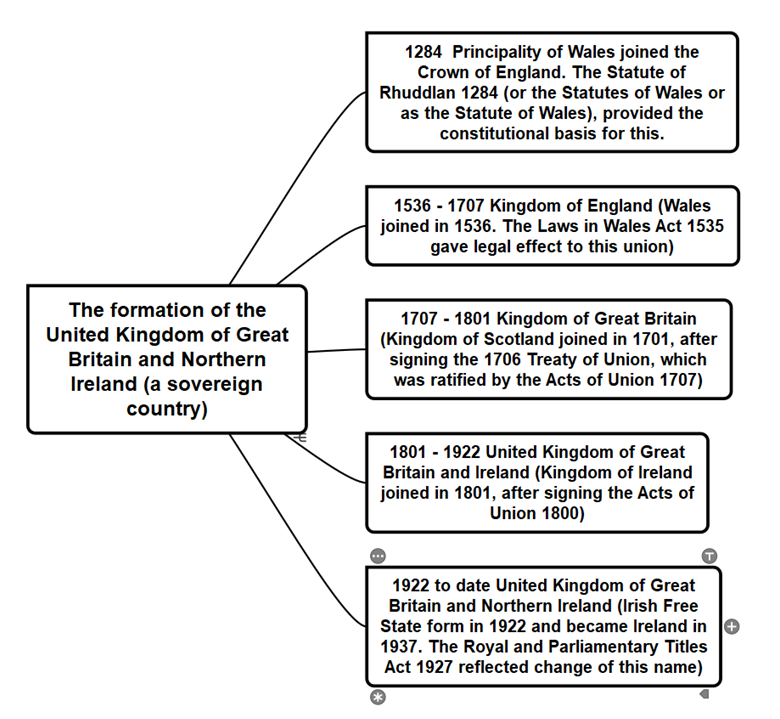Formation of the United Kingdom of Great Britain and Northern Ireland

The United Kingdom of Great Britain and Northern Ireland is a sovereign country. A sovereign country is a political entity that is represented by one government with sovereignty over a geographic area.
Sovereignty is a political concept. Its synonym can be ‘dominant power’ or ‘supreme authority.’ For example, in a monarchy, supreme power resides in the “sovereign” or a queen or a king. The Sovereign is the one who exercises power without limitation. Sovereignty is the power to make laws.
What does the UK Include?
The United Kingdom consists of four countries: England, Scotland, Wales and Northern Ireland. England, Scotland, Wales are located on the island of Great Britain. 8,000 years ago, it was not an island. It was connected to mainland Europe.
Northern Ireland is on another island, it borders Ireland.
Isle of Man, Guernsey and Jersey
These are Crown Dependencies (not British Overseas Territories). They are not part of the UK. Their official names are the Bailiwick of Guernsey, the Bailiwick of Jersey, and the Isle of Man.
They have a unique legal status. These are the territories for which the United Kingdom is responsible. However, they are not sovereign states. The Queen-in-Council has the power to pass legislation. However, they each have their own legislative assembly, with the power to legislate on many local matters with the assent of the Crown.
British Overseas Territories
There are 14 British Overseas Territories. Sometimes they are called United Kingdom Overseas Territories.
Below is the list of these territories:
- Gibraltar
- Akrotiri and Dhekelia
- Bermuda
- Turks and Caicos Islands
- British Virgin Islands
- Anguilla
- Cayman Islands
- Montserrat
- Pitcairn Islands
- Saint Helena, Ascension and Tristan da Cunha
- British Indian Ocean Territory
- Falkland Islands
- South Georgia and the South Sandwich Islands
- British Antarctic Territory
They are not Crown Dependencies. However, as Crown Dependencies, they do not form part of the UK itself. These territories only have some historical links with the UK.
These territories have various legal structures. For example, some are internally self-governing. However, the UK has responsibility for defence and foreign relations for these territories. Some territories have only military and scientific personnel.
All fourteen territories have the British monarch as head of state.
Formation of the United Kingdom of Great Britain and Northern Ireland: the Evolution Process
In very simple terms, the UK became the UK after 4 main events:
- Wales joined the UK (1284 and formalised in 1536)
- Scotland joined the UK (1707)
- Ireland joined the UK (1801)
- Ireland left the UK, but Northern Ireland remained as a part of the UK (1927).
Wales and England
Formally, Wales joined England in 1536. The Laws in Wales Acts 1535 provided the legal basis for Wales to join the Kingdom of England, its legal system the norms of English administration.
Also, this is when English language official became a ‘permissible language’ for official purposes. Parliament at Westminster became an official representative of its interests.
However, it is worth noting here that Wales (then Principality of Wales) joined England (then the Crown of England) in 1284. The Statute of Rhuddlan 1284 (or the Statutes of Wales) provided the constitutional basis for this. However, only in 1536 was Wales fully incorporated into the Kingdom of England.
Scotland and England
The Treaty of Union signed in 1706 (and ratified by the Acts of Union 1707) is the name of the agreement which led to the creation of the new state of Great Britain. The political union took effect on 1 May 1707, when Scotland officially joined ‘the Kingdom of England’.
Ireland and England
Approximately one century later, Ireland also joined the Kingdom of England. Both countries signed the Acts of Union in 1800.
From 1 January 1801, the Kingdom of England became ‘The United Kingdom of Great Britain and Ireland’.
Northern Ireland and England
In 1921 Ireland became ‘the Irish Free State’, leaving ‘The United Kingdom of Great Britain and Ireland’.
The 1921 Anglo-Irish Treaty provided legal basis for the establishment of the Irish Free State. The treaty also created ‘Northern Ireland’. The Government of Ireland Act 1920 gave ‘Northern Ireland’ option to opt-out of the Irish Free State. The Parliament of Northern Ireland (six north-eastern counties, all within Ulster) exercised this power and chose to remain a part of the UK and not to join the Irish Free State.
The Irish Free State was officially formed on 6 December 1922. It became known as Ireland in 1937. In 1949, after signing the Republic of Ireland Act 1948, it became the Republic of Ireland.
Why 5 Year Delay?
Although the Irish Free State was officially born on 6 December 1922, ‘The United Kingdom of Great Britain and Ireland’ changed its name to ‘The United Kingdom of Great Britain and Northern Ireland’ only 1927. However, some may argue that this happened considerably later.
The Royal and Parliamentary Titles Act 1927 was an act of the UK’s Parliament that authorised altering the British monarch’s royal style and titles. Also, it changed the formal name of the British Parliament in recognition of most of Ireland separating from the United Kingdom as the Irish Free State.
So, strictly speaking, the 1927 Act only changed the King’s title and the name of Parliament, but not the name of the country.
However, s2(2) brings some clarity. It provides:
‘In every . . . public document issued after the passing of this Act the expression “United Kingdom” shall, unless the context otherwise requires, mean Great Britain and Northern Ireland.’
Change of King’s Title
However, even after 1927 there are some inconsistencies with the name of the country. It’s interesting to note that according to Hansar records, the king’s, George V, the title was changed from:
‘George V. by the Grace of God of the United Kingdom of Great Britain and Ireland and of the British Dominions beyond the Seas, King, Defender of the Faith, Emperor of India.’
to
‘George V. by the Grace of God of Great Britain, Ireland and the British Dominions beyond the Seas, King, Defender of the Faith, Emperor of India’.
As you can see, even though section 2(2) specifically mentions ‘United Kingdom’ and clarifies what it includes, for some reason, the words ‘United Kingdom’ are omitted from the king’s title and the word ‘Ireland’ is used instead.
Formation of the United Kingdom of Great Britain and Northern Ireland
1953
In 1953 that, the Queen changed her title to:
‘Elizabeth II. By the Grace of God, of the United Kingdom of Great Britain and Northern Ireland and of Her other Realms and Territories Queen, Head of the Commonwealth, Defender of the Faith’.
Therefore, the name ‘United Kingdom of Great Britain and Northern Ireland’ was used consistently only after the queen’s coronation on 2 June 1953.
Ireland and Northern Ireland in 1973
In 1973, Northern Ireland had a referendum to see if it wants to join Ireland again. However, the majority chose to remain as a part of the United Kingdom.
In 1998, after Northern Ireland Good Friday Agreement, a Good Friday Agreement was signed to confirm this intention. This agreement has a clause that states that a border poll on Irish reunification must be held if public opinion is shown to have changed in favour of a United Ireland.
Unique Relationship of the UK and Ireland
Irish Citizens in the UK have a status almost equivalent to British Citizens. They can vote in all elections and even stand for parliament.
British Citizens have similar rights to Irish Citizens in the Republic of Ireland and can vote in all elections apart from presidential elections and referendums. People from Northern Ireland can have a right to Irish citizenship.
Which Act Defines British Citizens as citizens of the “United Kingdom of Great Britain and Northern Ireland”?
I suppose we can say it is the British Nationality Act 1981.
Sections 1-6 of the British Nationality Act 1981 define rules of acquisition of British citizenship.
For example, section 1 defines rules for acquisition by birth or adoption.
It states:
(1) A person born in the United Kingdom after commencement shall be a British citizen if at the time of the birth his father or mother is—
(a)a British citizen; or
(b) settled in the United Kingdom.
At section 50 (the Interpretations section) we can find the definition of “ the United Kingdom ”. According to section 50:
The UK means Great Britain, Northern Ireland and the Islands, taken together.
